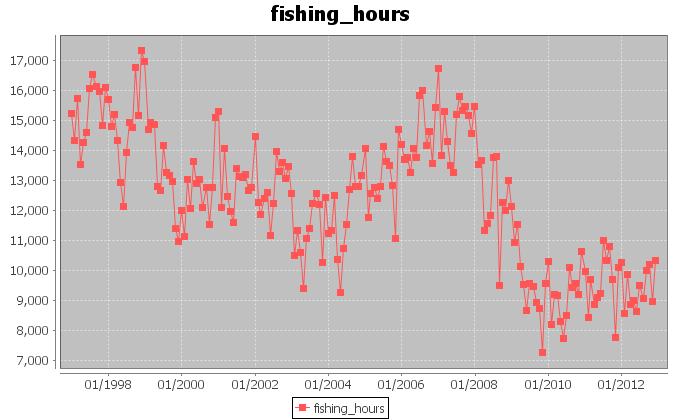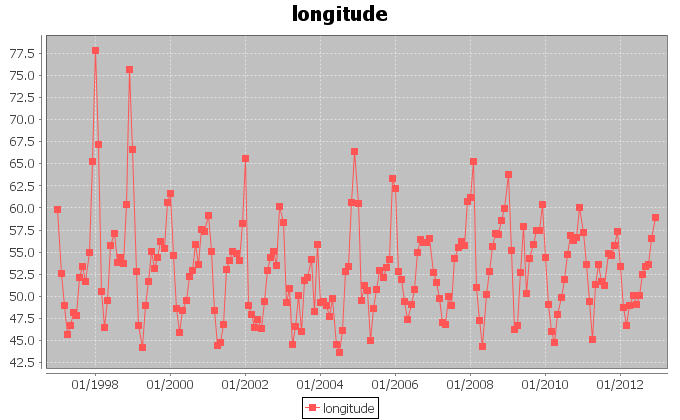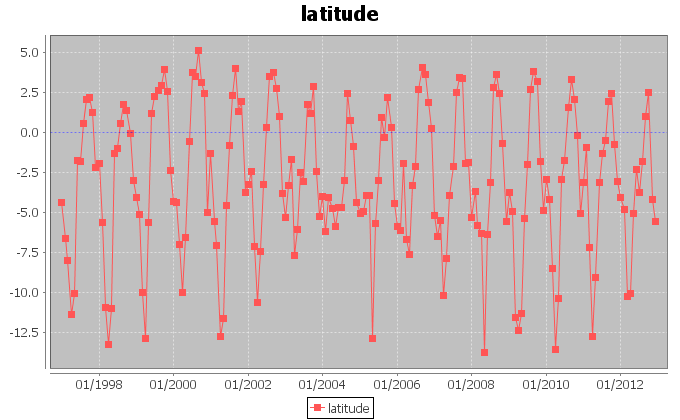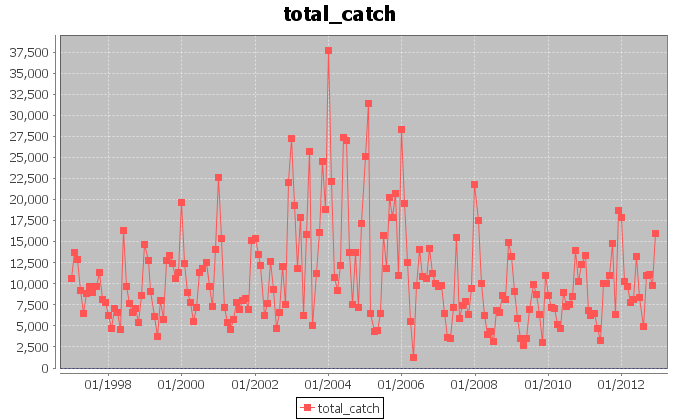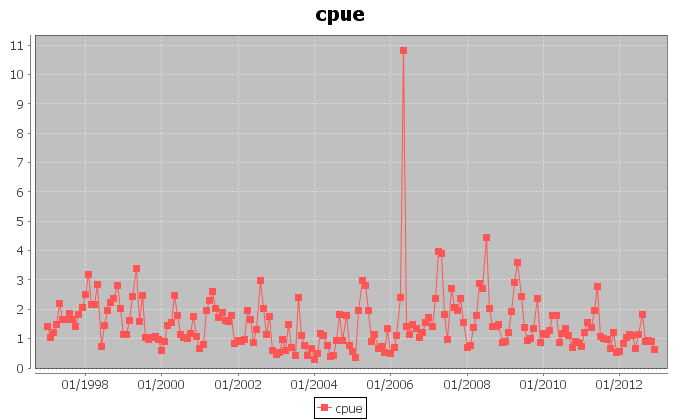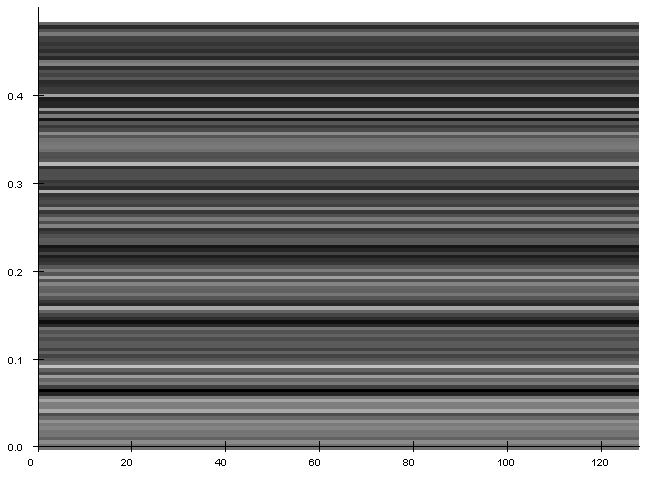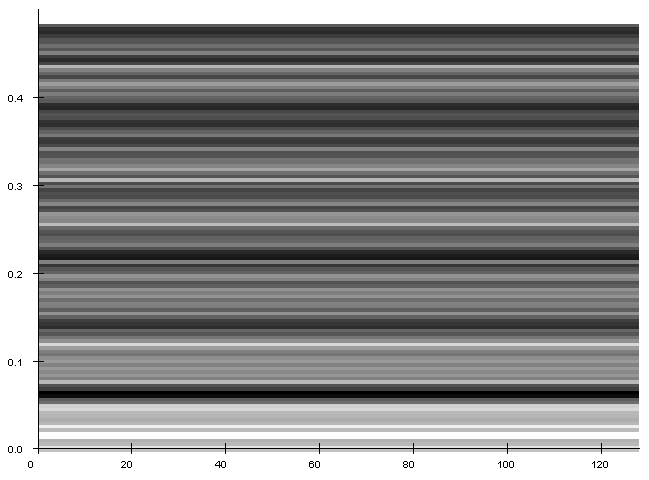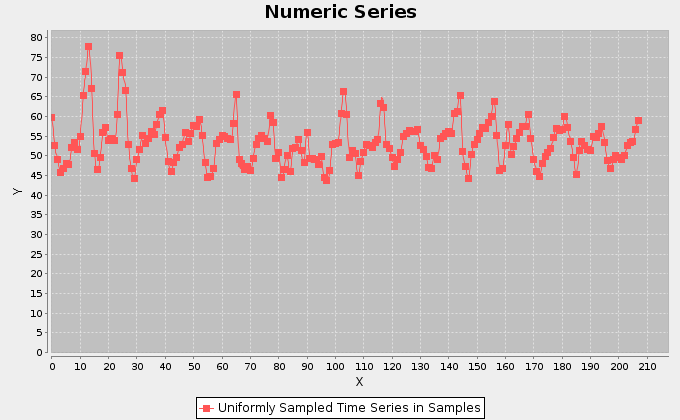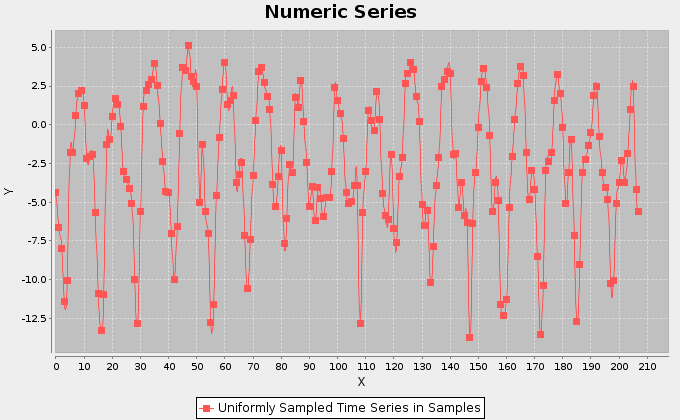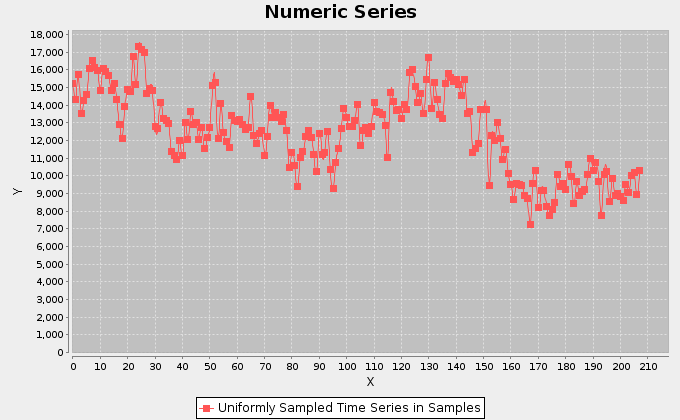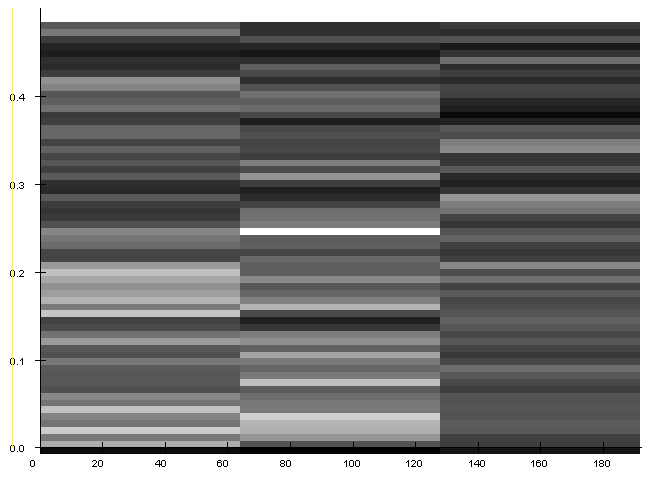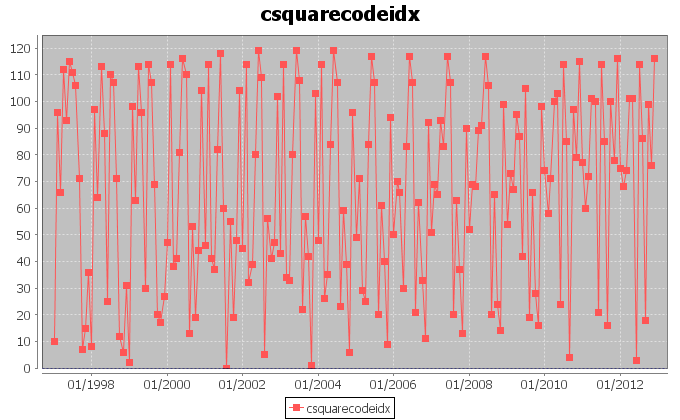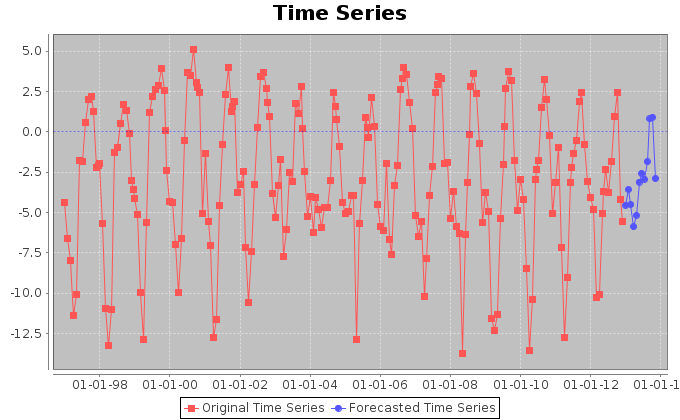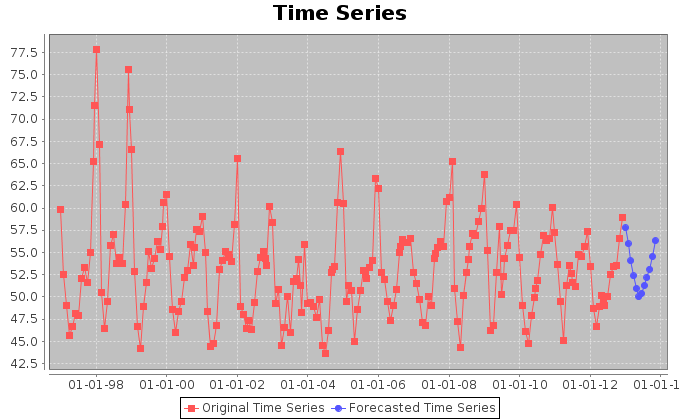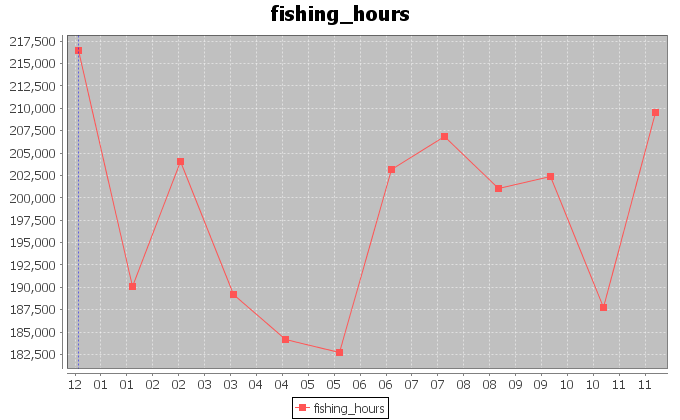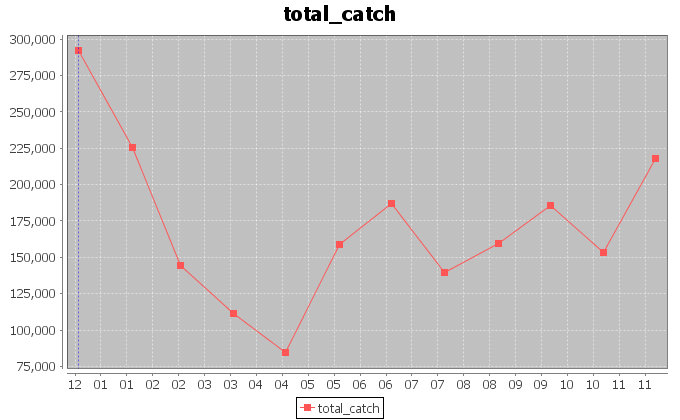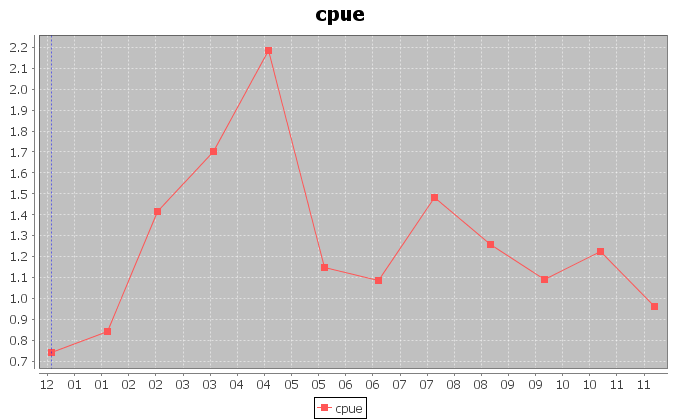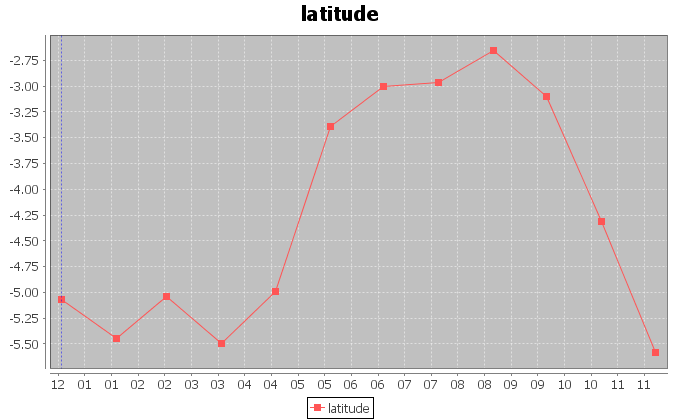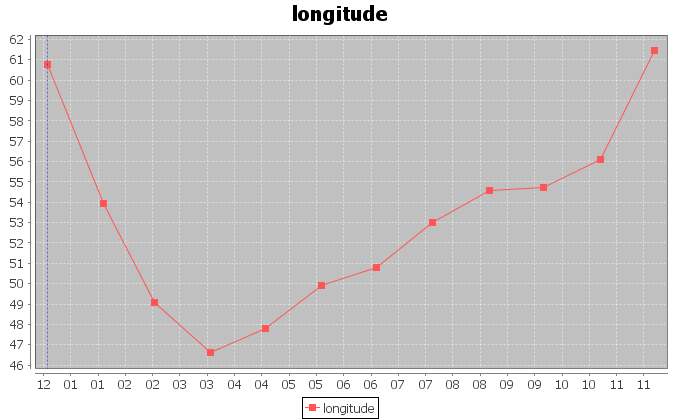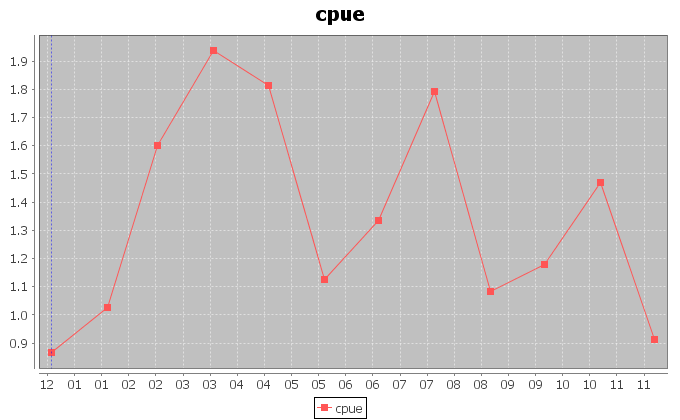Difference between revisions of "IOTC Area Predictive analysis"
(→Approach) |
(→Approach) |
||
| Line 4: | Line 4: | ||
==Approach== | ==Approach== | ||
| + | |||
Our first attempt aimed to discover hidden periodicities in the exploitation of the ocean area. Thus, we traced the trend of the fishing hours effort in the period between January 1997 and December 2012. We summed the hours spent in the same month and eventually obtained the trend in figure 1. | Our first attempt aimed to discover hidden periodicities in the exploitation of the ocean area. Thus, we traced the trend of the fishing hours effort in the period between January 1997 and December 2012. We summed the hours spent in the same month and eventually obtained the trend in figure 1. | ||
[[Image:barycentereffort.png|frame|Fishing hours aggregated per month along the entire period January 1997-December 2012]] | [[Image:barycentereffort.png|frame|Fishing hours aggregated per month along the entire period January 1997-December 2012]] | ||
| Line 53: | Line 54: | ||
| [[Image:barycentereffortsamples.png|thumb|center|upright=2.5|Fishing hours trend in samples.]] | | [[Image:barycentereffortsamples.png|thumb|center|upright=2.5|Fishing hours trend in samples.]] | ||
| [[Image:barycenterspectrogrameffort.png|thumb|center|upright=2.5|Spectrogram for the fishing hours trend.]] | | [[Image:barycenterspectrogrameffort.png|thumb|center|upright=2.5|Spectrogram for the fishing hours trend.]] | ||
| + | |- | ||
| [[Image:barycentereffort.png|thumb|center|upright=2.5|Forecasted trend for fishing hours.]] | | [[Image:barycentereffort.png|thumb|center|upright=2.5|Forecasted trend for fishing hours.]] | ||
|} | |} | ||
| − | We applied the same analysis to the fishing hours trend. The analysis detected a weak periodicity of 12.91 samples with indecision interval between 13.25 and 12.59. Furthermore, the forecast suggests that the amount of hours per month is going to oscillating aroung lower values in average, with respect to the previous years. | + | We applied the same analysis to the fishing hours trend. The analysis detected a weak periodicity of 12.91 samples with indecision interval between 13.25 and 12.59. Furthermore, the forecast suggests that the amount of hours per month is going to oscillating aroung lower values in average, with respect to the previous years. A periodic behaviour of 12 months is visible, which demonstrates that the latitude components is more relevant for latitude than for longitude. |
===Aggregation on 12 Months=== | ===Aggregation on 12 Months=== | ||
| − | |||
| − | [[Image:month12catch.png| | + | {|style="margin: 0 auto;" |
| + | | [[Image:month12effort.png|thumb|center|upright=2.5|Aggregation on 12 months of the number of Purse Seine fishing hours.]] | ||
| + | | [[Image:month12catch.png|thumb|center|upright=2.5|Aggregation on 12 months of the catch quatities.]] | ||
| + | |- | ||
| + | | [[Image:month12cpue.png|thumb|center|upright=2.5|Aggregation on 12 months of the CPUE for Yellfin Tuna.]] | ||
| + | | [[Image:month12latitudes.png|thumb|center|upright=2.5|Aggregation on 12 months of the barycenters latitudes.]] | ||
| + | | [[Image:month12longitudes.png|thumb|center|upright=2.5|Aggregation on 12 months of the barycenters longitudes.]] | ||
| + | |} | ||
| + | |||
| + | We repeated the same analysis aggregating the fishing hours on 12 months. The figure above displays the trends we extracted after the aggregation. The periodic nature of the fishing activity is no more visible, except for the latitudes of the barycenters. In this case. | ||
| + | |||
| − | |||
| − | |||
| − | |||
===Analysis on the Most Exploited Csquare=== | ===Analysis on the Most Exploited Csquare=== | ||
Revision as of 15:35, 21 May 2014
Description
Hypothesis and Thesis
Approach
Our first attempt aimed to discover hidden periodicities in the exploitation of the ocean area. Thus, we traced the trend of the fishing hours effort in the period between January 1997 and December 2012. We summed the hours spent in the same month and eventually obtained the trend in figure 1.
Furthermore, we associated the fishing hours in one single month to the barycenter of the areas interested by the fishing activity in that month. The monthly barycenters were calculated by weighting each 1 degree cell in the original dataset according to the fishing hours spent in that month in the cell. The resulting dataset can be found here. This contains unfolded information about the barycenters coordinates and their distance from the origin of the reference system. Figure 2 and 3 display the trends for the longitudes and latitudes of the barycenter. The signals show a periodic behaviour, which we investigated more accurately. In figures 4 and 5 we report the trends for the amount of catch in tonnes of the Yellowfin Tuna and the related catch per unit of effort (CPUE) calculated as the ratio between the catch and the fishing hours.
In order to inspect the periodic behaviour of the trends of the coordinates, we applied Fourier analysis to the signals and traced the spectrograms. In both the cases, the analysis detected a period of 51.0 samples with indecision in the interval [56.64 , 46.38] , which corresponds to a periodic exploitation of some areas after 51 months.
Fishing effort, instead, is not a stationary signal, thus we tried to inspect its hidden periodicities by means of a Short-Time Fourier analysis. The analysis was made on chunks of the signal with quite stationary mean and variance in the samples values.
We also report the trend of the Csquare codes associated to the barycenters. Each code was assigned to an index and the chart displays the distribution of such indexes in time. This is one way to report a bidimensional occurrence on one dimension.The trend of the indexes is periodic and this is due to the periodic trend in longitudes and latitudes.
Finally, we tried to forecast the coordinates trends in order to understand which places could be interested by exploitation in the 12 next months. To such aim we used Singular Spectrum Analysis. The forecasts confirm the periodic nature of the signals.
We applied the same analysis to the fishing hours trend. The analysis detected a weak periodicity of 12.91 samples with indecision interval between 13.25 and 12.59. Furthermore, the forecast suggests that the amount of hours per month is going to oscillating aroung lower values in average, with respect to the previous years. A periodic behaviour of 12 months is visible, which demonstrates that the latitude components is more relevant for latitude than for longitude.
Aggregation on 12 Months
We repeated the same analysis aggregating the fishing hours on 12 months. The figure above displays the trends we extracted after the aggregation. The periodic nature of the fishing activity is no more visible, except for the latitudes of the barycenters. In this case.
Analysis on the Most Exploited Csquare
| Csquare code | Exploitation (fishing hours) |
|---|---|
| 3005 | 614135.3 |
| 1005 | 709254.3 |
| 3004 | 513798.8 |
| 3104 | 211621.1 |
| 3006 | 258669.6 |
| 3105 | 24718.3 |
| 1004 | 12235.1 |
| 3004 | 513798.8 |
| 3007 | 33038.7 |
